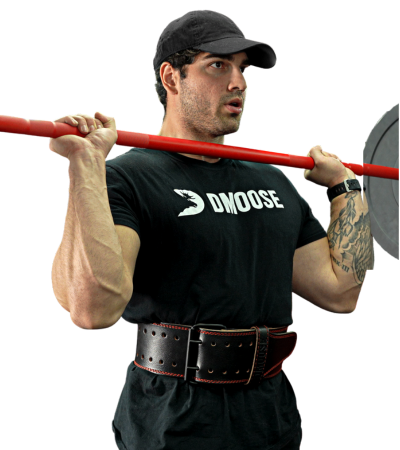Most powerlifters and many heavy-lifting icons you see in the gym don't rely on raw strength alone—they have a secret ally: the weightlifting belt. Research shows that using a custom weightlifting belt can actually increase your power and support your spine during lifts, making each session safer and more effective.
Understanding when to wear a weightlifting belt can transform your lifting technique and results. It’s not for every exercise, but when you aim to lift heavier than usual or tackle high-intensity lifts, a belt can provide that crucial support and stability. This equipment is designed to help you enhance performance while protecting your most valuable asset—your back.
This article answers the most important question: ‘When should you use a weightlifting belt’ and so much more.
When Should You Use a Weightlifting Belt?

Deciding when to use a weightlifting belt is all about understanding your training goals and the type of exercises you're performing. Here’s a straightforward guide on when to strap on that belt:
For Heavy Lifting
The most common recommendation for using a weightlifting belt is during heavy lifting sessions. This typically means exercises where you're lifting loads that are 80% or more of your one-rep max.
Think squats, deadlifts, and overhead presses. In these scenarios, a belt can help maintain good form and reduce the risk of back injuries by increasing abdominal pressure and stabilizing your spine.
During Max Effort Lifts
When you’re pushing your limits with max-effort lifts, a weightlifting belt can be invaluable. These are the lifts where you attempt to set personal records, and the extra stability from a belt can make a critical difference, providing the support needed to safely execute the lift.
For Long Lifting Sessions
During prolonged lifting sessions where fatigue sets in and form might start to slip, a weightlifting belt can serve as a reminder to keep your core engaged and your spine in a safe alignment.
This can be particularly useful for intermediate to advanced lifters who are working with challenging weights over extended periods.
Here’s how to use a custom weightlifting belt:
- Wrap the belt around your middle, finding the sweet spot between your ribs and hips where it feels supportive but doesn’t restrict your movement.
- It should be snug enough to tighten when you breathe in deeply but not so tight that it’s uncomfortable or cuts off your breath.
- You should be able to slide a couple of fingers between the belt and your body fairly easily, and you should use the prongs or lever to adjust it until it feels just right.
When Not to Use a Weightlifting Belt

While a weightlifting belt can be a valuable tool for heavy lifting, it's equally important to know when to leave it out of your gym bag. There are certain types of workouts and training days where the use of a belt is not only unnecessary but might even be counterproductive.
For Lighter Workouts
It’s crucial to avoid using a weightlifting belt during lighter workouts or when focusing on lower weights for high repetitions. These types of exercises aim to build muscular endurance or perfect lifting technique, where core strength and stability should be developed naturally.
During Routine Training Days
On routine training days, when the focus is not on pushing your limits with heavy weights, a weightlifting belt might not only be unnecessary but could also hinder the natural strengthening of your core muscles.
Using a weightlifting belt is not about wearing it for every lift or every workout. It's about strategic use during those key moments when the extra support can lead to performance gains while protecting your body from injury.
Making smart decisions about when to wear a weightlifting belt can enhance your training effectiveness and help you achieve your lifting goals safely.
Our Recommended Best Weightlifting Belt

For those dedicated to lifting heavy and pushing their limits, the DMoose 5mm Powerlifting Belt stands out as a superior choice. Crafted from genuine leather, this leather weightlifting belt is robust and designed to endure the rigors of intense training sessions.
Enhanced Support
- 4-Inch Lumbar Support: Provides substantial back support, crucial for maintaining proper posture and reducing the risk of injury during heavy lifts.
- 5mm Thickness: Balances support with comfort, suitable for various lifting techniques.
Secure Fit
- Double-Pronged Buckle: Ensures the belt stays securely fastened, providing consistent support without slipping during your routine.
Adjustable Sizing
- Variable Sizes: Available in multiple sizes to accommodate a wide range of waist measurements, ensuring a perfect fit for lifters of all sizes.
Added Convenience
- Carry Bag Included: Comes with a practical carry bag, making it easy to store and transport, keeping your belt protected and ready for your next session.
Whether you’re a seasoned powerlifter or someone looking to enhance their training regime, the DMoose 5mm Powerlifting Belt provides the support needed to lift safely and effectively.
For more details, you can view the product here:DMoose 5mm Powerlifting Belt
What Does a Weightlifting Belt Do?

A leather weightlifting belt is more than just a piece of gym equipment; it's a critical tool that supports and enhances the efforts of weightlifters, from beginners to seasoned pros. Whether you're looking to boost your performance, protect your body, or fine-tune your lifting technique, understanding the role of a weightlifting belt can be a real deal in your training routine.
Enhancing Spinal Support
It is a staple in the toolkit of many serious athletes, especially those who engage in heavy lifting. Its primary function is to add support to the lower back while lifting heavy weights.
This support helps stabilize the spine, making it safer to lift heavier loads than you might otherwise handle without such support.
Increasing Intra-abdominal Pressure
When you lift heavy weights, the belt provides a wall for your abs to push against. The added force with minimal space helps to increase intra-abdominal pressure, which better supports the spine during heavy lifts.
This is crucial because maintaining a strong, stable spine is essential for performance and injury prevention.
Improving Lifting Technique
Beyond back support, wearing a weightlifting belt can also help improve your lifting technique by reminding you to keep your back straight and properly aligned. This is important not just for safety but also for effective force transfer throughout your body.
Proper technique ensures you engage the right muscles and maximize your efficiency during each lift.
Boosting Performance
In terms of performance, a study suggests that using a custom weightlifting belt can increase muscle power and help you generate more force. This can be particularly beneficial during maximal or submaximal lifts such as squats and deadlifts.
A belt can help you perform better, safely push your limits, and possibly even lift more weight than you could without one.
The Bottom Line
Incorporating a quality weightlifting belt like the DMoose 5mm Powerlifting Belt into your training routine can significantly enhance your lifting performance and safety.
This belt offers crucial support, helping to maintain proper posture and protect the spine during intense lifts. Suitable for a range of athletes, from powerlifters to CrossFit enthusiasts, it provides the durability and adjustability needed for various body types and training requirements.
Discover more about this essential equipment and other reliable lifting gear at DMoose to improve your training experience.
Reading List
Can Wearing a Belt for Overhead Press Increase Performance?
Traveling With Your Lifting Belt: A Guide to Stay Fit On-The-GoMaster the Fit With a Quick Guide to Measuring a Weightlifting Belt
15 Best Weightlifting Belts for Powerlifters
Traveling With Your Lifting Belt: A Guide to Stay Fit On-The-Go
7 Simple Tips to Choose the Right Weightlifting Belt | Do Not Get Scammed
Article Sources
- Fong, Shirley S. M., et al. “The Influence of Weightlifting Belts and Wrist Straps on Deadlift Kinematics, Time to Complete a Deadlift and Rating of Perceived Exertion in Male Recreational Weightlifters.” Medicine, vol. 101, no. 7, Feb. 2022, p. e28918. PubMed Central, https://doi.org/10.1097/MD.0000000000028918.

















